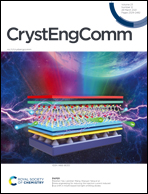Syntheses of a series of lanthanide metal–organic frameworks for efficient UV-light-driven dye degradation: experiment and simulation†
Abstract
Three new Ln(III)-based metal–organic frameworks (MOFs), having general formula [Ln2(L)2(ox)(H2O)2]n (Ln = Nd (1), Sm (2) and Eu (3)), have been synthesized using multifunctional triazole–carboxylate linker 5-(1H-1,2,4-triazol-1-yl)-1,3-benzenedicarboxylic acid (H2L) and another dicarboxylate ligand oxalate (ox2−). The single crystal X-ray diffraction studies indicate that all three complexes are isostructural in nature and show unique 3,8-connected 3D networks with a point symbol of (42·6)2(39·412·57) topology. All three MOFs possess various types of weak interactions in their framework and these have been assessed using Hirshfeld surface analyses and fingerprint plots. The Nd-based MOF 1 is also used as a photocatalyst for the degradation of organic dye methyl violet (MV) under UV light irradiation. The photocatalytic experiments revealed that MOF 1 offered good photocatalytic properties to photo-decompose MV. Additionally, the most potent radical responsible for the photodegradation of MV under UV irradiation was checked using different radical scavengers. The plausible photocatalytic mechanism of 1 aided photocatalysis is explained with the help of theoretical band gap calculations using density of states (DOS) and partial DOS plots.

- This article is part of the themed collection: Supramolecular & Polymorphism


 Please wait while we load your content...
Please wait while we load your content...